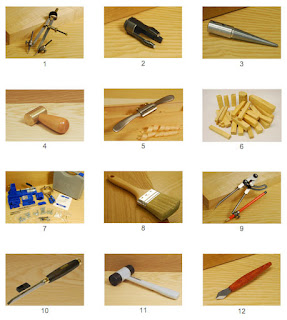Flatness is possibly one of the more widely misunderstood aspects of precision woodworking, by experienced and novice woodworkers alike. Most woodworking courses tend to start with sharpening and tuning - because you can't work without sharp well tuned tools. I would suggest that a better starting point might be a theoretical understanding of flatness, because with that you can better understand what you are aiming to achieve when sharpening and tuning - and save yourself bags of time and effort in the process.
Right, goatee beards and berets at the ready - let's bust some myths!
Perfectly flat! - BUSTED!
From an engineering perspective, absolute flatness is a conceptual state that is approached to within a given tolerance. Nothing has ever been made that is absolutely 100% flat, however we can get extremely close to it. Good quality reference surfaces like straightedges and surface plates will have a stated tolerance, the smaller the tolerance the closer the tool is to flat, straight, square etc. The smaller the tolerance gets, the more expensive it becomes to achieve.
It is worth mentioning that the tolerance on a straightedge is one of the factors that needs to be taken into account when expressing the measurement taken against it. Avoid buying cheap tools described as 'precision' but without a stated tolerance, you are genuinely better off with a banana. A straightedge with a 0.003" tolerance might sound impressively straight, but if you go to take a 2 thou measurement against it, you could be out by 75%. Would you buy a tape measure that gave you two feet plus or minus 18 inches?
I have scoured the suppliers for a straightedge that is both reasonably priced and sufficiently accurate and settled on the
Bowers Metrology 465 Engineers Straightedge (same company group as Moore & Wright) which gives accuracy of 0.0005" over it's 500mm length and still comes in on the right side of £75 (at the moment).
Rub it on a flat thing. - PLAUSIBLE! (sometimes)
A common myth is that rubbing something on a big flat abrasive surface will automatically make it flat too. However, when you think about it, every slight variation in pressure as you move the object over the surface will have a cumulative effect. The flat surface prevents you from making it concave, so what this process actually achieves is altering the condition of the surface in the direction of convexity. If it was concave to begin with then you will indeed be making it flatter, if it was flat or even minutely convex then the only possible outcome will be greater convexity. Abrading on a larger abrasive surface is a useful technique, but only when it is understood and used appropriately to reduce concavity or intentionally introduce convexity.
When it comes to making wood flat with a hand plane we use 'stop shavings' or
shavings within the length of the workpiece to introduce very slight
concavity (equivalent to the depth of cut over the length of the sole).
These are followed by 'through shavings' that move us back in the
direction of convexity - too many through shavings and you will end up
with a convex workpiece. Although the tools are different and we are
cutting rather than abrading, the principles are exactly the same.
Approaching flatness from known concavity in a controlled manner.
Concavity can be introduced or increased by working the object over an abrasive surface that is smaller than itself. In the case of a chisel this can be achieved by working across the width of the stone, or if lapping a plane by using a piece of abrasive that is shorter than the sole. Once the surface is uniformly slightly concave it can then be worked on a larger abrasive surface to bring it back towards flat.
I've seen the light! - Plausible! (But it ain't a measurement)
Seeing light under a straightedge
or square is not a very satisfactory method of inspection because light
is subatomically thin. Take a bench plane that is flat to British
Standard of 3 thou on centreline for example. An optic fibre core has an
external thickness of 1/3 of one thou (that's the thickness of the tube
as well as the hole for the light inside it). In other words you could
stack eight optic fibres on top of each other and slide the lot through a
three thou gap. A
feeler gauge
on the other hand gives you a definitive yes or no answer about whether
the gap is bigger or smaller than the thickness of the feeler. The only thing light can do is tell you whether or not you need to bother getting the feeler gauges out. In other words it's a quick initial check, seeing no light is an automatic pass, but seeing light only identifies a need for proper measurement.
A word about tolerances
Tolerances are usually expressed as 'X thou maximum total deviation on centreline' if you think of this as 'would an X thou feeler guage go under it?' you are using the appropriate numbers. They can also be expressed as +/- Y thou, this gives you the deviation up or down, so to check for it you would need a feeler gauge twice as thick as Y thou. You can also have unilateral tolerances that only allow deviation in one direction, for example =/- Z thou allows for a concavity of Z thou with no tolerance for convexity.
If you have any questions or comments please feel free to post them here and I will do my best to answer them. In part two we will get a little deeper into the specifics of tool tuning and sorting out some of those eBay horrors.























































